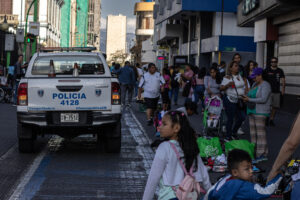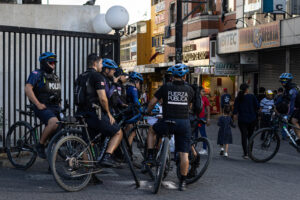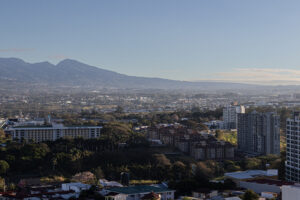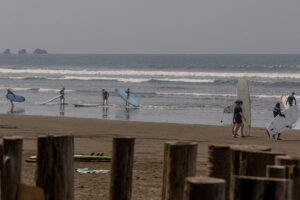- Slug: Borderlands-Costa Rica Crime. 3,000 words.
- Photos available (thumbnails, captions below).
- Data visualization available here.
By Carly Stoenner
Cronkite Borderlands Project
SAN JOSÈ, Costa Rica — Dense jungles, pristine beaches, towering volcanoes, and a welcoming attitude toward visitors have caused tourists to flock to this peaceful nation for decades, but a wave of crime is now threatening paradise.
In 2023, Costa Rica welcomed 2.7 million visitors, according to the country’s Tourism Institute. Tourism has risen steadily since the end of the COVID pandemic.
The country’s reputation, however, is now being threatened by a rising crime rate due to an influx of illicit drugs and sharp rise in drug trafficking. Meanwhile, the fight against crime in Costa Rica is stymied by unprecedented migration flows, increased inequality and an understaffed police force.
According to Costa Rica’s Judicial Investigation agency (OIJ), there were more than 900 homicides in 2023— marking the most violent year in the country’s history. The murders were primarily attributed to narcotrafficking groups.
Mario Zamora, director of the Ministry of Public Safety, said the homicides are mainly carried out by members of criminal gangs fighting for territory, and typically occur in poor neighborhoods where the drug markets are stronger. He thinks that in the future it could have a disastrous effect on the two main sources of income for the economy: tourism and foreign investment.
“Costa Rica, as you know, is a country that has not had an army since 1949 and has been an extremely peaceful country since then, so there is a great social impact due to the increase in the homicide rate, and last year we had 906 homicides in a population of 5.2 million inhabitants,” Zamora said.
Esteban Rojas, a Costa Rica tour guide with more than 15 years of experience, said tourism is the main economic driver for the country.
“It’s a chain reaction. You have a hotel, but you need curtains, you need tomatoes and lettuce for breakfast. You need screws and cleaning products. Then for the tour buses, you need the tires and the mechanics. Then there’s the people that work in restaurants and cleaning,” Rojas said. “This applies to the big picture because once a location has money from tourism, other businesses emerge that have nothing to do with tourism. For example, all women who decide they now want to get their nails done because they have the money. That’s one of the main differences between tourism and other kinds of industries. It’s very social and stimulates the local economy.”
According to statistics from the Costa Rica Tourism Institute, approximately 163,000 people were directly employed by the tourism industry in 2023, accounting for 7.1% of the labor force. When considering both direct and indirect employment, the figure increases to around 490,000 individuals, or 21.3% of the labor force.
Costa Rica’s drug trade
According to officials at the U.S. Embassy in Costa Rica, part of the explanation for the rise in homicides is the increasing consumption of cocaine, particularly in the form of crack, and the competition among cartels to control the local drug market.
The revenue that the local drug trade generates has also become a principal driver of corruption, according to officials at the U.S. Embassy, adding to the country’s challenges.
Randall Zúñiga, director of Costa Rica’s Judicial Investigation agency (OIJ), attributes the rise of cocaine in Costa Rica to new technologies that have reduced the cost of production in Colombia.
“Before, in Costa Rica, one kilo of cocaine cost about $7,000. Right now, one kilo costs around $3,500 or $4,000,” Zúñiga said.
Coca crop production in Colombia and other countries has dramatically increased in the post-COVID era, resulting in more and cheaper cocaine, according to a report from the United Nations Office on Drugs and Crime.
“[D]rug trafficking groups have created alternative markets on route to the United States,” Zamora said. “Costa Rica previously had low cocaine consumption, and today, according to our data, we have more than 100,000 users.”
According to the U.S. Embassy, Costa Rica has been the first stop for cocaine from South America on its way to the United States or Europe since 2020. The country now serves as a logistical hub for traffickers.
The drug trafficking groups involved in this trade are Colombia’s Clan de Golfo on the southern end of the country and Mexico’s Sinaloa and Nueva Generation on the northern end. These groups, along with local Costa Rican drug trafficking organizations, work together as partners to move their product.
According to a report from the U.S. State Department, since 2020, “Costa Rica has ranked among the top first-stop transshipment points for cocaine headed from South America to the United States and Europe, leading to increased crime and related corruption.”
Costa Rica’s principal commercial port in the province of Limon, the port of Moín, has been the source of cocaine smuggled to Europe in commercial cargo containers.
In recent years, major drug trafficking organizations began to pay for Costa Rican logistical services in cocaine instead of cash, according to U.S Embassy officials, meaning more product remained in Costa Rica in the control of local drug trafficking organizations that can now market and commercialize the product at home.
The amount of drugs coming into Costa Rica as payments is so large that the country’s local illicit drug market cannot absorb it, said Stephen Brunner, one of Costa Rica’s two vice presidents.
“The gangs fight for these zones where they want to sell their drugs exclusively,” Brunner said. “As long as they [the cartels] were paying with cash, in terms of security, there were no side effects of the drug dealing. But once they started to pay ‘in-kind’ with the drugs, now the only thing we can do is make the country less attractive for exporting drugs to the U.S. and Europe.”
Criminal activity at the community level
Jacó is a popular beach town in Costa Rica due to its proximity to the Central Valley, where the majority of the country’s population lives.
“That makes Jacó an attraction for everything, for good and for bad,” said Leonidas Ruaro, president and founder of Pura Vida Fighting for Kids. The small non-profit organization offers free classes in Brazilian Jiu-Jitsu, yoga and chess for vulnerable youth in the area.
The district of Jacó de Garabito had the highest rate of reported crimes against foreign tourists from 2021 to 2023, according to official crime data from the OIJ.
“The fact is that this happens in most tourist places in the world — drug addiction, prostitution, criminality, and maybe Jacó is demonized a little bit,” Ruaro said. “But we have had a wave of new types of gangs and organized crime. We’ve had a strong wave of gruesome crime that we’ve never felt in my entire life of living in Jacó. We’ve never had that ugly fear that we’ve had in recent times.”
According to Ruaro, Colombian organizations previously dominated the drug territory in Jacó, a time that he says was less violent because the groups had taken care not to interfere with tourism. But he says there are new groups now, including some from Nicaragua that are financed by Mexican cartels, whose involvement has led to rising levels of violence.
Large waves of Nicaraguan and Venezuelan migrants have fueled the idea that foreigners are bringing drugs and crime to the country. However, according to OIJ’s Zúñiga, official data says only 5% to 10% of crime is committed by foreigners.
A rise in gangs in Costa Rica has multiple causes, including the fact that many young people dropped out of school early due to the pandemic, Zúñiga said.
“There are a lot of youngsters that right now don’t have a formal education, so they have to go to an irregular employer, let’s say, which is criminal organized crime,” Zúñiga said.
Ruaro said that often many of his Jiu-Jitsu students even suffer from violence in their homes, which is why Pura Vida Fighting for Kids tries to provide a safe space for them.
“This type of program is what makes the kids who are a prospect [for gangs] ready to be able to take on the [temptation] of drug addiction, prostitution, selling drugs, and so on, and to look for another type of path, the path of good,” Ruaro said. “The less you are on the street, and have a safe space where you feel loved and listened to, we are already giving them something they don’t have.”
According to the State of the Nation Report 2023, a research document created by five public universities in Costa Rica, emergency 911 operators recorded 123,000 incidents of domestic violence in 2022, or approximately 15 reports per hour, every day of the year.
The report also said that in 2022, Costa Rica experienced the highest level of inflation in the last 14 years, at 12.1%. The cost of living mainly rose due to a 59% increase in the cost of food and a 17% increase in the cost of transportation.
According to the Report, low-income households earned approximately $430 per month. Families whose incomes came from domestic services, recreational activities, hotels, and restaurants showed negative savings rates, meaning many households are resorting to debt to cover their expenses.
“Sometimes those kids just eat rice and beans, sometimes just rice and egg, and sometimes just rice, do you know what I mean?” Ruaro said. “There is poverty and there is extreme poverty, and extreme poverty is when they don’t even have enough to eat.”
Rojas, the tour guide, said the biggest gangs operate on the Caribbean side of the country. According to the National Institute of Statistics, this area e also has some of the country’s highest levels of multidimensional poverty at 24% of the population.
“It’s a part of the country where there is less opportunity for youth. There’s not a lot of industry, so the government, every four years when there’s elections, they talk about the opportunities that they’re going to give to the province of Limón, and in the end two things out of a hundred happen,” Rojas said. “So that’s the thing — because there are fewer opportunities for the kids, they change the books for the guns, right.”
According to the State of the Nation Report 2023, there were 3.4% fewer people employed in the country in 2023 than in 2019. Rojas said it’s setting off alarm bells in terms of the safety of the country.
“Not so much in the tourism aspect, but in society. People are saying ‘Hey government, what’s going on?’” Rojas said. “We have been living in the land of Pura Vida, and right now it feels stressful. So what’s going on?’”
Costa Rican government responds
According to Zúñiga, a decrease in public spending to reduce Costa Rica’s foreign debt and a lack of police officers has exacerbated the problem.
He said there should be about 4.2 police officers for every 100,000 people, leaving Costa Rica behind by about 5,000 officers.
Zúñiga said the government is in the process of passing new laws in the National Assembly that strengthen penalties against youths in gangs, enforce stricter gun laws and allow the extradition of foreigners found guilty of crimes. He believes this will have an impact in the long term, but falls short of addressing an immediate need for more police officers.
According to Zamora, the budget for the Ministry of Public Security grew by $40 million in 2023, allowing for the addition of 600 officers. In 2024, he said, the ministry created an additional 900 positions, for a total of 1,500 new police officers.
Brunner additional police officers will do little to reduce violent crime in the country.
“That won’t help because they now [kill] in daylight. They do it in front of schools. They do it even 100 meters from the police station,” Brunner said. “Our laws are too soft for this kind of delinquency, and we need to change that. When foreign assassins come, they laugh at us and they say, ‘This system is a paradise.’ What we need to change is the judicial system.”
According to Zamora, the Costa Rican government is putting cargo drug scanners in all of their ports, limiting the ability of criminal organizations to export drugs. Four of the scanners were pledged by the U.S. on March 23, 2024, in addition to $40.5 million to provide increased security assistance, according to embassy officials.
“With that, we are killing the core of the business,” Zamora said. “When a criminal organization doesn’t have that lucrative activity, it goes to another country. We hope this will have an impact on the fight.”
However, according to Brunner, narcotrafficking groups will do almost anything to avoid detection, including smashing the scanners, cutting telecommunications cables, monitoring the movements of coast guard vessels and using dinghies at night to load the containers after scanning. He said the list also includes using submersibles to load cargo underwater.
“Their creativity has no limit,” Brunner said. “They try to do everything you can imagine.”
Ruaro said he agrees with the government’s ‘iron fist’ approach, but that the problem is more complex than that.
“Not even the government of the United States of America has been able to stop this [drug trade]. Imagine a government like ours that doesn’t even have an army,” Ruaro said. “So I think, as they say, ‘kill them with love.’ The most important thing is to have things that go hand in hand — an iron fist, but also hand in hand with love, and where we can provide a lot of spaces like these, to the youth, to all the people.”
He says that teaching martial arts has a different approach, one that instills discipline, respect, friendship and familial bonding.
“We’re more good than bad and that’s very important, because the more good spaces for our community, the less of those types of bad people,” Ruaro said. “If there’s a dark place where they meet to sell crack, and that place is beautified and the lights turned on, the bad people leave.”
Crime threatens Costa Rica’s reputation
Costa Rica has experienced a boom in tourism in the last decade, directly related to the image of the country. Rojas said the country’s main attraction includes the relaxed atmosphere and friendliness towards foreigners.
“The ‘Pura Vida’ style works well in moments when life is stressful and complicated. When they [foreigners] come here they feel a relief,” Rojas said. “Even though it’s not exactly like that, right? It’s also a clichè — especially lately.”
In addition, the government’s protection of nearly a third of the country’s natural resources sends a positive message to tourists.
“It’s a brand. Costa Rica is like a Louis Vuitton bag, right? You think of Costa Rica and immediately you think of ecotourism, green, the Pura Vida, right?” Rojas said. “It’s a time when sustainability, ecological, and organic is a brand that attracts a lot of people.”
Rojas identified other factors that add to the country’s positive image: It has no army; the political system is democratic and stable; it has a stable economy; and the social fabric is strong.
“People that come over here, they know that they’re not going to be trapped by a war or by riots on the streets. People come here knowing, thinking, believing that everything is going to be nice,” Rojas said. “The word of mouth is out there, right? It’s what has attracted the most — people come, they have great times, they go back, and then the people ask them ‘So is it dangerous? Is it bad?’ ‘No, it’s Pura Vida, it’s beautiful.’”
The highest rates of crime against foreigners in 2023, according to the OIJ, were reported in the coastal communities of Jacó de Garavito (279), Cahuita de Talamanca (194), Quepos de Quepos (151) and Bahia Ballena de Osa (120).
According to U.S. Embassy officials, criminal organizations in these areas are also using Airbnb cleaning staff to provide information on when a house listed for tourists will be occupied and what potential items inside.
Rojas points out that the tourism industry in Costa Rica doesn’t have a ministry, despite being one of the largest economic drivers in the country. Instead, he says, the Tourism Institute’s efforts are primarily focused on marketing the country externally.
“That’s why we have places like Jacó. The ecology has been destroyed, and then society through gentrification has been completely destroyed,” Rojas said. “There’s no planning.”
“All the grandparents sold their property [to foreigners] — beachfront or close to the beach. Now their grandchildren work as guards, housekeepers and cooks in the same place where the grandparents sold the property for a tiny profit,” Rojas said. “They now have to live in the back neighborhoods where there’s no water treatment, the housing is terrible, almost a slum, and the social desperation and crime comes from there.”
Rojas said it’s a chain reaction, believing that the Tourism Institute has done little to encourage sustainable development, despite being one of its main duties. The Tourism Institute did not respond to a request for comment for this article.
“The Tourism Institute doesn’t care,” Rojas said. “What they care about is 1 million more tourists coming. But how are you going to invite 1 million people to your house when you have no room? Your house is all dirty. You have no running water. All the water is contaminated where the tourists will be eating, right? And that’s what’s happening with the country right now.”
Zamora said the changes occurring in Costa Rica are a phenomenon that is not only regional but global. He says that when citizens start following criminal organizations instead of the rule of law, those criminal groups replace democracy.
“There is a misconception that many people believe, that this is solely a criminal problem,” Zamora said. “It’s more than that. It’s a risk to democracy and the democratic system.”
For more stories from Cronkite News, visit cronkitenews.azpbs.org.






